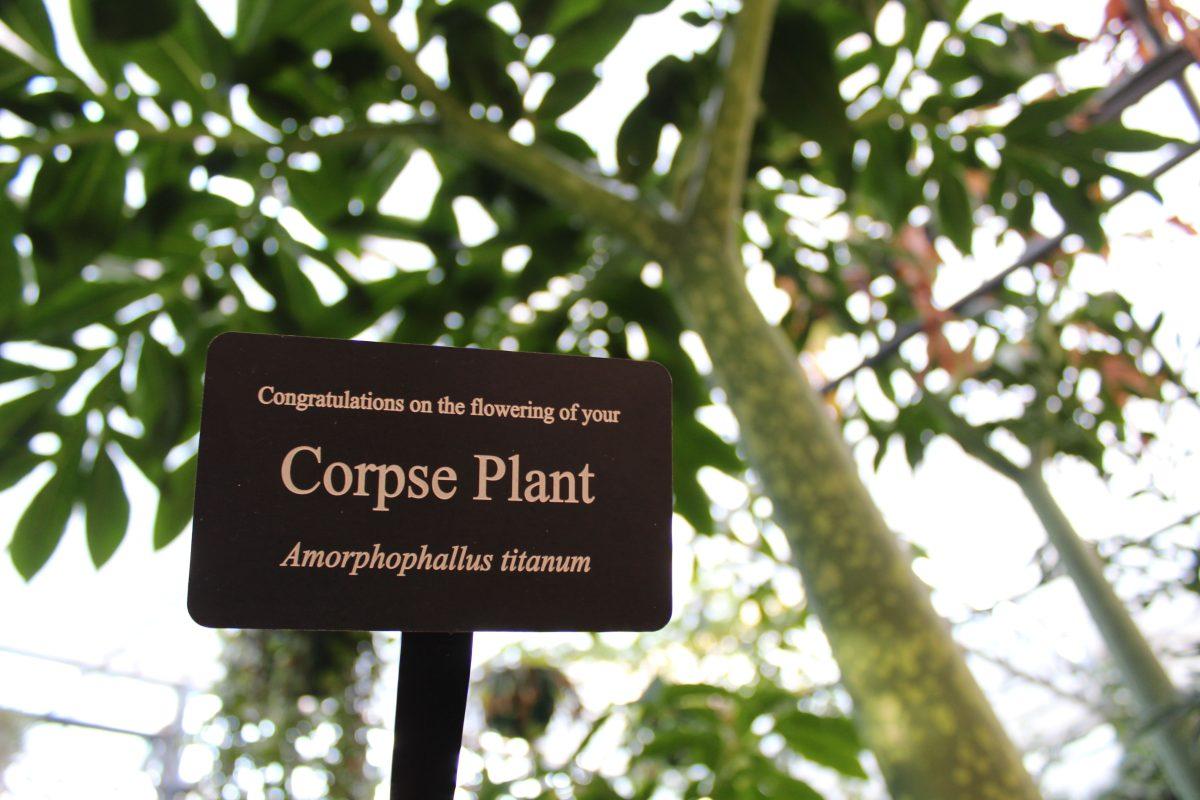Nestled in a forest of tropical plants, two giant 12-foot tall green spotted plants dominate the canopy of the Marye Anne Fox greenhouse. But would you believe these plants shrivel down to the ground, bloom into the world’s biggest flower and smell like rotting corpses?
Dr. Brandon Huber, a graduate of the master’s and doctoral horticulture programs at NC State, is the acquirer and primary caretaker of NC State’s Amorphophallus titanum, which are better known as corpse plants after the horrible stench they emit while flowering.
Huber said corpse plants are the world’s largest flowering plants and are native to the rainforests of western Indonesia. The rarity of the plant drew Huber to acquire Lupin, his most mature plant, from the Huntington Botanical Garden in California over 10 years ago.
“I’m a rare plant grower, and I’ve always been searching for the next cool rare plant to grow,” Huber said. “A part of wanting this plant was to grow this world’s largest flowering species, and this plant has done very well for me.”
In Lupin’s 19 years of life, the plant has bloomed three times. It first bloomed in 2016, then in 2019 and most recently in 2021. Huber said it takes at least 10 years before corpse plants can start producing flowers.
Currently, Lupin is in its dormant state as a 12-foot tall leaf that is storing energy from the sun for its next bloom. Huber said in late 2023 or early 2024, Lupin’s leaf will fall over and wither away before a flower emerges from the 120-pound tuber at the base of the plant. Next, the flower will bloom for one or two days, releasing a corpse-like stench before it shrivels and dies, beginning the cycle anew.
Huber said the reason the flower smells like corpses is to attract pollinators who normally feed on carrion.
“They produce this odor to draw out pollinators, like we think of a sweet-smelling flower that will draw bees,” Huber said. “This plant has a nasty smell to draw flies and carrion beetles. Actually, things that will typically go to roadkill pollinate this plant.”
Adding to the facade of roadkill, Huber said corpse plants are thermogenic, meaning they produce heat while flowering.
“They heat up to sometimes 15 degrees warmer than the surrounding air environment to simulate,” Huber said. “Because a lot of these pollinators these insects see thermal better, they can see the heat. So they’re drawn to the smell and the temperature. It’s really interesting. So it’s kind of, again, simulating this corpse or this rotting thing.”
Lupin isn’t the only corpse plant at NC State. Huber has cloned Lupin multiple times, with five of them at the plant’s side in the greenhouse. Huber said Wolfgang, the second most mature corpse plant on campus, is preparing to bloom for the first time this upcoming spring with the plant’s leaf already beginning to become rubbery in texture. Lupin and Wolfgang both stand about 12 feet tall, while the younger plants have not passed five feet yet.
Huber said while obtaining corpse plants has become easier over the last few years, flowering a corpse plant is a major achievement for botanists due to the special care they require as tropical plants.
“There [are] over a thousand [corpse plants] in cultivation in the US, however there [have] not been that many that have flowered,” Huber said. “Lupin was probably the 200th bloom in the nation.”
Diane Mays, plant conservatory curator and teaching support specialist in NC State’s horticulture program, said the greenhouse livestreamed Lupin’s first bloom where it reached 36,000 views and upwards of 2,000 visitors in the two days it was in bloom. Mays said each time the plant blooms, it provides a unique time for the College of Agriculture and Life Sciences to come together for a common interest.
“The entomologists came over because its pollination is due to carrying beetles and carrying flies, and then the plant biologists came over because of the thermogenesis that it developed in terms of getting those pollinators,” Mays said. “It was one of those plants that brought us all together.”
Huber said what fascinates him the most about the corpse flower is the range of people it attracts.
“I’ve never seen a plant generate so much interest,” Huber said. “I think the coolest thing for me about growing this plant is its ability to bring people to come out and appreciate a plant; we get thousands of visitors that come in here to see this plant when it flowers, and it’s really cool. People from all walks of life — they don’t have to be plant people or plant growers or horticulturists, it just brings all these people in here.”













